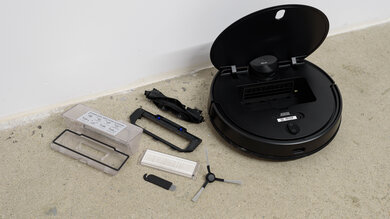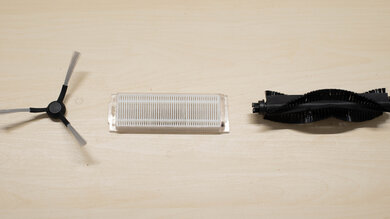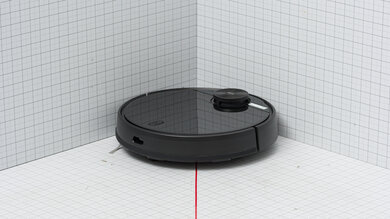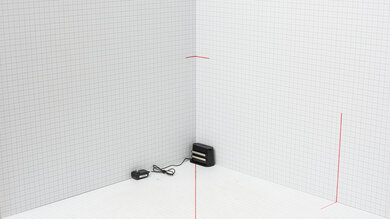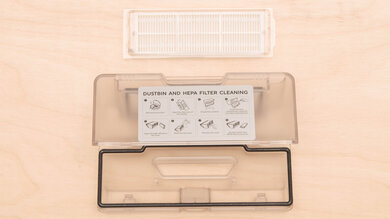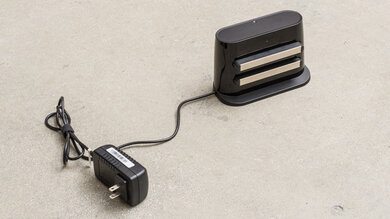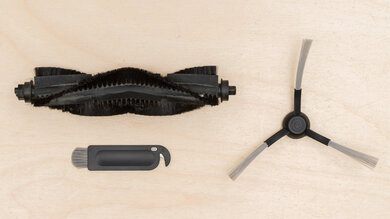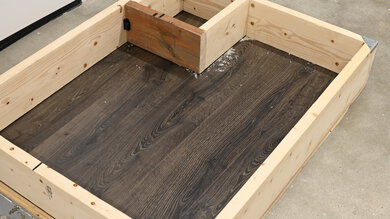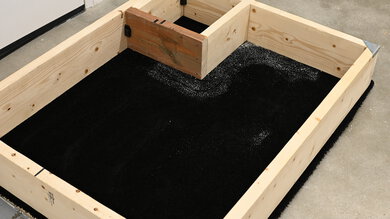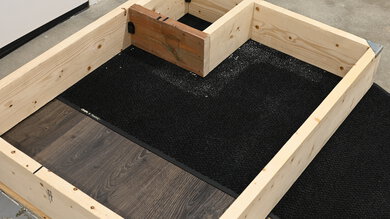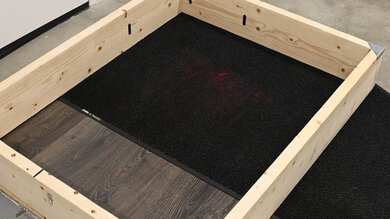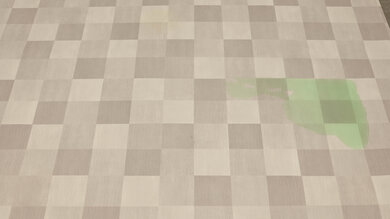The Wyze Robot Vacuum is a lower mid-range robot vacuum. It features a wide range of automation capabilities and LIDAR mapping, allowing you to schedule cleaning sessions for specific rooms and set up virtual no-go zones for areas that you don't want to enter. It also features a HEPA exhaust filter that helps it seal in fine allergens. However, it doesn't have a mopping system and isn't compatible with a self-emptying base station.
Our Verdict
The Wyze Robot Vacuum is an alright performer on bare floors. It's very well-built and delivers good performance on surfaces like hardwood and laminate, where it easily clears pet hair and debris. It also does a good job of maneuvering itself in an organized pattern. Unfortunately, it has a small dirt compartment and incurs high recurring costs.
-
Great build quality.
-
Excellent battery life.
-
Great automation features.
-
Small dirt compartment.
-
High recurring costs.
-
Great build quality.
-
Great automation features.
-
Small dirt compartment.
-
No automatic surface type adjustment feature.
-
Great build quality.
-
Great automation features.
-
Small dirt compartment.
-
No automatic surface type adjustment feature.
-
Great build quality.
-
Excellent battery life.
-
Has an allergen-trapping HEPA filter.
-
Small dirt compartment.
-
High recurring costs.
-
No automatic surface type adjustment feature.
-
No mopping system.
- 6.6 Bare Floor
- 6.2 Low-Pile Carpet
- 6.3 High-Pile Carpet
- 5.3 Pets
- Updated Aug 22, 2024: We've added a link to the eufy L60 in the 'Low-Pile Carpet Pick-Up' section of the review to provide an alternative that performs better on low-pile carpeting.
- Updated Jul 23, 2024: We've added text to this review for the new tests added in Test Bench 0.8.
- Updated Jun 25, 2024: Converted to Test Bench 0.8.
- Updated Mar 20, 2024: Minor in-text changes to better convey product information.
- Updated Dec 14, 2023: Converted to Test Bench 0.7.
- Updated Feb 02, 2023: We've updated the text in the review to account for the new tests and scoring methodology in Vacuum Test Bench 0.5 and Vacuum Test Bench 0.6.
- Updated Jul 29, 2022: Converted to Test Bench 0.6.
- Updated Mar 18, 2022: Converted to Test Bench 0.5.
- Updated Mar 16, 2021: Review published.
- Updated Mar 12, 2021: Early access published.
- Updated Mar 05, 2021: Our testers have started testing this product.
- Updated Mar 04, 2021: The product has arrived in our lab, and our testers will start evaluating it soon.
- Updated Feb 10, 2021: We've purchased the product and are waiting for it to arrive in our lab.
Differences Between Sizes And Variants
The Wyze Robot Vacuum is available in one color variant: 'Black.' You can see the label for the unit we tested here.
If you come across another variant or yours is different, please let us know in the discussions, and we'll update our review.
Compared To Other Robot Vacuums
The Wyze Robot Vacuum is a robot vacuum with a fantastic performance on bare floors and does a good job cleaning pet hair from carpets. It's an excellent alternative to the Shark Matrix Robot, a mid-range LIDAR mapping robot vacuum, as it delivers superior debris pickup performance on most floor types, though, unlike the Shark, it isn't compatible with a self-emptying base station.
To see more options, check out our lists of the best robot vacuums, the best robot vacuums for pet hair, and the best robot vacuums for carpet.
The Wyze Robot Vacuum and Roborock Q5 each have advantages. The Roborock can be bundled with a self-emptying dock, potentially reducing hands-on maintenance requirements. It also has a longer battery life than the Wyze, and you can use its companion app to direct it manually if you get stuck. However, the Wyze feels better built, does a much better job of sealing in allergens, and takes less time to recharge.
The Wyze Robot Vacuum is better than the iRobot Roomba i3. The Wyze has fewer parts requiring regular maintenance, incurs lower recurring costs, lasts longer on a single charge, and delivers better performance on bare floors and carpets. However, the iRobot does have an automatic surface adjustment feature and a self-emptying function that reduces hands-on maintenance requirements.
The eufy L60 and the Wyze Robot Vacuum are pretty evenly matched robot vacuums with similar feature sets and designs. The eufy is the better option for homes with a lot of carpets or rugs, thanks to its 'BoostIQ' feature, which can automatically increase its suction power setting depending on the surface it's on. The eufy is also marginally easier to maintain and has a bigger dustbin that you won't have to empty as often. Meanwhile, the Wyze delivers better debris pickup performance on hard floors. It feels better built, too.
The Wyze Robot Vacuum and the Roborock E4 have a very similar look and performance, but the Roborock is better for most uses. The Roborock has a larger dirt compartment, has a longer maximum battery life, and clears more pet hair from carpets. On the other hand, the Wyze has a more advanced navigation system, and its app allows you to set virtual boundaries for the vacuum and create cleaning schedules for individual rooms, which isn't possible with the Roborock.
The Wyze Robot Vacuum is better than the Shark AI Robot. The Wyze's LIDAR mapping sensor allows for quicker, more precise room mapping. It has a considerably better companion app, though the Shark does offer a similarly broad suite of automation features, like support for no-go zones. The Wyze also feels better built, is more effective in clearing away pet hair, and is easier to maintain. However, the Shark has a larger dustbin and a longer battery life.
The Wyze Robot Vacuum is better than the eufy RoboVac G20. The Wyze has a more advanced LIDAR mapping system that enables it to store a permanent map of its coverage area, meaning you can use its companion app to schedule cleaning sessions for specific rooms or set up virtual boundary lines. The Wyze also feels better built, has fewer parts that need periodic cleaning, incurs lower recurring costs, does a better job of dealing with pet hair, is more maneuverable, and is more effective in sealing in fine particles. Conversely, the eufy has a slightly larger dustbin and weighs less.
The Wyze Robot Vacuum and iRobot Roomba j7/j7+ each have advantages. The iRobot provides a more hands-off cleaning experience, with real-time object identification to spot and avoid hazards like pet waste, automatic power adjustment for different floor types, and compatibility with a self-emptying base station. That said, the Wyze offers better overall debris pickup performance and has a longer battery life.
The iRobot Roomba i4 and Wyze Robot Vacuum each have advantages, so one may suit you better than the other, depending on your needs. The iRobot has a larger dirt compartment, requires less time to charge, and delivers better performance on high-pile carpets. Conversely, the Wyze is less demanding in terms of maintenance requirements, incurs fewer recurring costs, has a longer runtime in its least powerful suction mode, and cleans debris more effectively on bare floors.
The Roborock S6 and the Wyze Robot Vacuum are very similar robot vacuums, but the Roborock is better for most uses. The Roborock's dirt compartment is much bigger, and it has a better battery performance. It also has an automatic surface type adjustment feature. On the other hand, the Wyze is easier to maintain and delivers significantly better performance on high-pile carpets.
The Wyze Robot Vacuum is better than the Shark AI Ultra Robot. The Wyze feels sturdier, is easier to maintain, clears away more pet hair, does a better job on bare floors, and has a markedly superior companion app. However, the Shark is compatible with a self-emptying base station to reduce hands-on maintenance requirements.
The Roborock S7 MaxV is better than the Wyze Robot Vacuum. The Roborock has both a LIDAR sensor for quick mapping and a front-facing camera for spotting and identifying potential hazards in real-time. Unlike the Wyze, it also has an advanced mopping system that's quite effective in scrubbing away stains. Lastly, it's fully compatible with two types of self-emptying stations, the pricier of which refills its water tank, washes its mopping pads, and empties its dustbin. The Wyze is a good option if you don't need those additional features and simply want a LIDAR robot vacuum with good overall debris-pickup performance.
The Wyze Robot Vacuum is better than the eufy RoboVac 25C. The Wyze feels better built, is easier to maintain, has a longer battery life, and delivers better debris pickup on most floor types. It also has a LIDAR sensor, which results in much faster and more efficient pathing than the eufy's random-pathing system.
The Wyze Robot Vacuum is superior to the iRobot Roomba 694. The Wyze has fewer parts that need periodic cleaning, uses an allergen-trapping HEPA filter, maneuvers itself more effectively, and performs better on bare floors as well as low- and high-pile carpets. You can also use the Wyze vacuum's companion app to set up virtual boundary markers or schedule cleaning sessions for individual rooms. Conversely, the iRobot has a larger dustbin and charges much faster.
The Wyze Robot Vacuum is better than the iRobot Roomba 675. The Wyze is easier to maintain, performs better on most surface types, does a better job of clearing away pet hair, and has a more advanced LIDAR mapping sensor, which results in superior maneuverability and a more robust suite of automation features, like support for no-go zones and scheduling for individual room cleaning sessions.
The Ecovacs DEEBOT OZMO T8 AIVI is better than the Wyze Robot Vacuum. The Ecovacs has a more advanced mapping and navigation system, which combines a LIDAR sensor with a camera that allows it to spot and react to hazards in front of it in real-time. It also feels better built than the Wyze, cleans carpets better, has a larger internal dustbin, and has a longer battery life. It's also capable of mopping up stains, though its mopping system is entirely passive and not especially efficient, and is fully compatible with a self-emptying station. That said, the Wyze is far more affordable and delivers superior performance on bare floors.
The iRobot Roomba 981 and the Wyze Robot Vacuum have different strengths, and you may prefer either one depending on your needs. The iRobot can automatically adjust its suction power depending on the surface type it's cleaning, and it delivers better performance on bare floors as well as low-pile carpets. On the other hand, the Wyze delivers much better performance on high-pile carpets, and its companion app allows you to set virtual boundaries to keep the vacuum out of certain areas.
The Wyze Robot Vacuum is better than the eufy RoboVac G30. The Wyze has better build quality, fewer parts that need to be cleaned regularly, lower recurring costs, a longer maximum battery life, and a more advanced LIDAR mapping system that allows you to set up virtual boundary markers or schedule cleaning sessions for specific rooms. It also delivers better performance on all surface types. Meanwhile, the eufy has a larger dustbin and an automatic suction power adjustment feature.
The Wyze Robot Vacuum is a better vacuum than the yeedi K650. The Wyze delivers better performance on all surface types and has much better automation features. It also has a better build quality and is easier to maintain. On the other hand, the yeedi has a bigger dirt compartment, charges more quickly, and has a longer maximum battery life.
The Wyze Robot Vacuum is slightly better than the Roborock S4 Max. The Wyze has fewer parts that require regular maintenance and delivers superior performance on bare floors as well as low- and high-pile carpets. While the Wyze charges a lot faster, the Roborock has a longer maximum runtime, but it's worth mentioning that this can vary in the real world. The Roborock also maneuvers itself more effectively and has a larger dirt compartment.
Test Results
The build quality is great. The vacuum is made of hard plastic and has a glossy black top with a cover you can lift to access the dirt compartment. The rubber wheels feel durable, but the dirt compartment feels somewhat fragile. It's very easy to assemble out of the box since you just need to attach the side brush and set up the dock.
This vacuum is passably easy to maintain. There are quite a few parts that need to be serviced regularly, but they're all easy to access.
- Dirt compartment: The dirt compartment is located under the glossy black cover on top of the vacuum and can be easily lifted free by pressing the grooves on its sides. You should empty it over a garbage can whenever it's full. Taking it out or putting it back in triggers a voice notification.
- HEPA filter: The HEPA filter can be unclipped from its slot in the dirt compartment very easily. You should use the cleaning tool to remove any debris every two weeks.
- Brushroll: To remove this component, lift the cover under the vacuum and pull it out. The included cleaning tool does make it a little easier to cut away any stuck-on hair, but longer strands can be a bit of a hassle to deal with, as they tend to get wrapped around its bearings. The manufacturer doesn't say how often you should clean it, but you should clean the bearing and clear any hair tangles with the cleaning tool regularly.
- Side brush: Unlike a lot of other robot vacuums, the side brush isn't fixed in place with a screw, and you can pull it out of its slot pretty easily. It isn't especially hard to clean, either. You should clean it about once a month.
- Boundary sensor: You should clean the sensor regularly by wiping it with a soft cloth.
This vacuum has fairly high recurring costs. There are a few parts that need regular replacing. Conveniently, you can use the Wyze app to track how many hours of cleaning time are left until each part needs replacing.
- HEPA filter: You should replace it every three months or after 150 hours of use. You can find a replacement here.
- Side brush: You should replace it every three months or after 200 hours of use. Replacement brushes are only sold as part of the Maintenance Kit and can't be purchased individually.
- Brushroll: You should replace it every six to 12 months or after 300 hours of use. You can find a replacement here.
You can also get all of these components as part of a 'Maintenance Kit,' which includes:
- 4x HEPA filters
- 2x brushrolls
- 4x side brushes
This vacuum is somewhat modestly sized. It's short enough to squeeze under most chairs, couches, and tables. Its charging dock also takes up very little room.
This vacuum has excellent battery performance. On its most powerful 'Strong' mode, it provides just over an hour of continuous cleaning time. If you use the lower-power 'Quiet' mode, it lasts for just over two hours. It'll be sufficient for cleaning most large rooms, though it's worth noting newer alternatives like the Roborock Q5 can last even longer on a charge. When the remaining battery life reaches less than 20 percent, it stops cleaning and tries to return to its dock. The LED indicator light on top will start to blink yellow as well. It takes about 3.5 hours to recharge, which isn't too long, although some robot models charge much more quickly, like the iRobot Roomba 614.
This vacuum doesn't have many extra features. Two buttons are on the top, 'Power' and 'Home.' Pushing the 'Power' button once will start or pause a cleaning cycle while holding it for three seconds will turn the vacuum on or off. The 'Home' button sends the vacuum back to its dock. You can also use the app to set the suction power setting to 'Quiet,' 'Standard,' or 'Strong,' but you have to do it manually. Unfortunately, the Wyze can't automatically adjust those settings depending on the surface it's on, unlike the Roborock E4.
This vacuum delivers decent performance on high-pile carpet. It's good at dealing with medium-sized and large debris on this surface type, though you still might have to clean up with a manual vacuum to deal with debris left in corners and along walls. You might also want to have it run another cleaning session to clear away finer debris like sand that's been worked into carpet fibers.
We initially encountered some difficulty testing this vacuum on our black sample carpet, as its cliff sensors would trigger and cause it to stop moving. To get around this issue, we covered the sensors with white gaffer tape. This isn't a solution we recommend for actual day-to-day use, but it's worth keeping in mind if you have a home with especially dark-colored carpets.
Performance on low-pile carpet is okay. The vacuum will need to make an extra pass or two to deal with finer debris like sand that's been worked deep into carpet fibers, but it's quite good at picking up larger debris. If you want a robot vacuum that provides better performance on this surface type, the eufy L60 is a good option.
This vacuum doesn't exert all that much in the way of suction force, though this isn't unusual for a robot vacuum; its suction inlet is positioned too high above the ground to generate a tight seal on bare surfaces, so real-world suction measurements are quite low.
Airflow performance is okay for a robovac. The Wyze doesn't deal with heavier debris as easily as a higher-end model like the Roborock S8, but it'll still outperform the vast majority of similarly priced alternatives.
The Wyze Robot Vacuum isn't very noisy, especially when compared to most manually operated vacuums. However, you still might want to consider an alternative like the eufy RoboVac G20 if quiet operation is a priority.
This vacuum has good maneuverability. It tends to start by moving around the edge of a room and then cleaning in an organized pattern of straight lines. The smart pathing feature allows it to become more efficient with each run, and it gets noticeably better at cleaning around obstacles like chair legs after a few cleaning sessions. It's small enough to go under low furniture like coffee tables and couches, but, unfortunately, it gets stuck on electrical cords and rug tassels. It can navigate on high-pile carpets but can pull rugs around, which could be annoying if you have small area rugs or doormats.
This vacuum does a great job of sealing in fine allergens, thanks in part to its high-efficiency post-motor filter.
This vacuum does a poor job of cleaning crevices. It isn't quite powerful enough to draw debris out of deeper cracks. Thankfully, unlike alternatives like the Roborock Q5, its side brush doesn't scatter messes around when lifting debris from cracks.
The Wyze Robot Vacuum has terrible stain-clearing performance. Unlike the Roborock S5, it doesn't have a mopping feature that would allow it to scrub away dried-on stains.
Physical automation features aren't especially extensive. Unlike the Shark EZ Robot Self-Empty, the Wyze isn't compatible with a self-emptying base station. It uses its LIDAR navigation system to map your home as it cleans for the first time. The vacuum will only connect with 2.4GHz Wi-Fi networks, as it won't detect 5GHz networks. If you want to use the vacuum without an internet connection, you can use the buttons on the top to either send it back to its dock or have it pause or resume an ongoing cleaning session.
The Wyze companion app is great. You can use the LIDAR-generated map to create virtual boundaries to keep the vacuum out of certain areas or set cleaning schedules for individual rooms. You can also use the app to start, stop, and send the vacuum back to its dock, change the suction power setting, check when parts need to be replaced, see the cleaning history, and check the remaining battery life. You can 'share' the vacuum with other household members so they can control it from their phones.



